Rembrandt Van Rijn
BlogAdmin on 27th May 2022
Rembrandt Harmenszoon Van Rijn, simply known as Rembrandt, was a Dutch Golden Age painter, printmaker and draughtsman. He is generally considered one of the greatest visual artists in the history of art and the most important in Dutch history. Rembrandt was born in the year 1606 in Leiden, Netherlands. He became famous among art lovers because of his history paintings and etchings. He is also well-known for his self-portraits and paintings on biblical scenes.
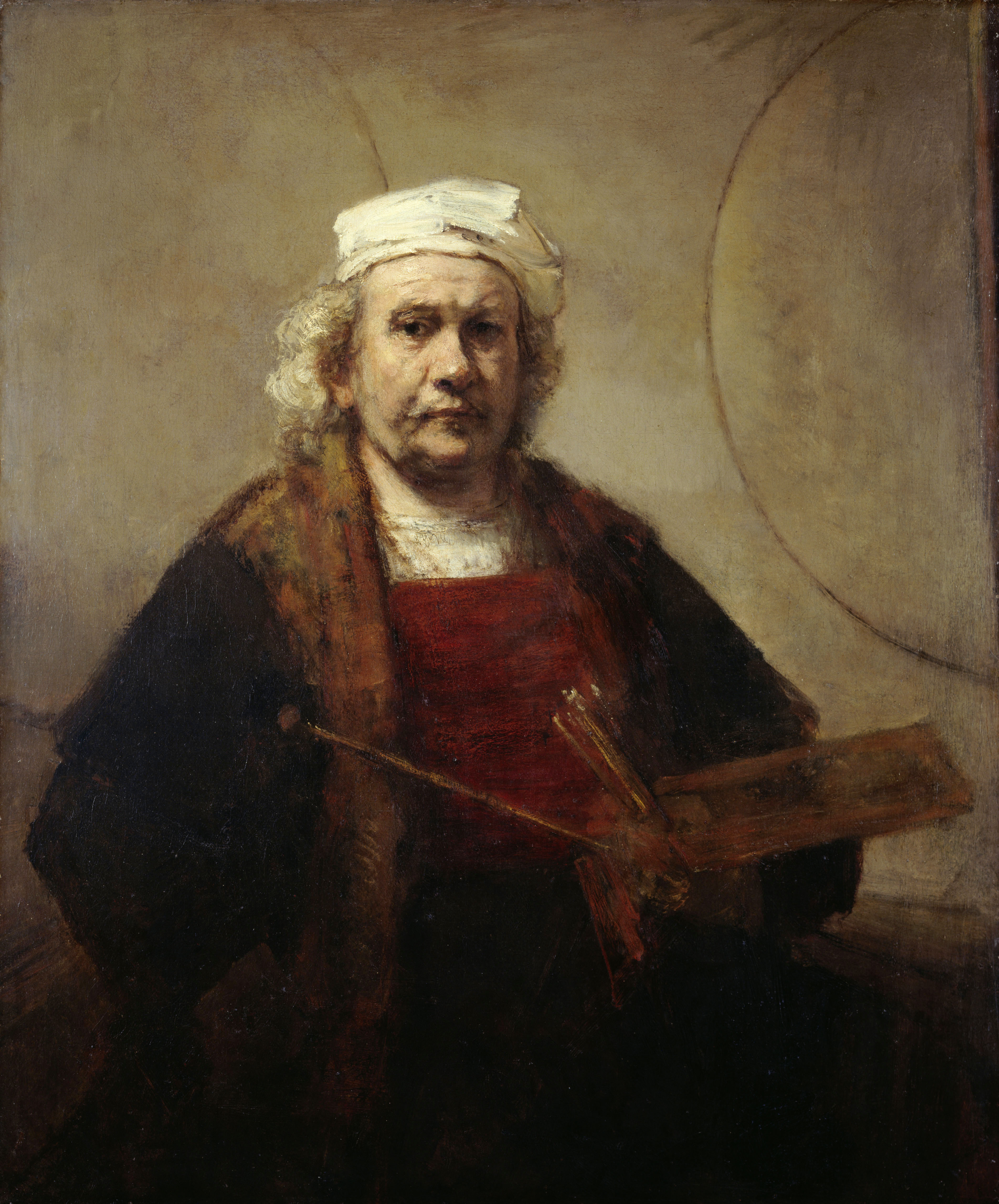
Rembrandt was the fourth of the six surviving children out of his parent’s ten. Unlike many painters who had artistic parentage, Rembrandt’s father was a Miller and his mother came from the family of bakers. He signed his early age paintings with the monogram ‘RH’ (Rembrant (not ‘dt’) Harmenszoon). At age twenty-six, he started signing with his first name, ‘Rembrandt’. From 1633 onwards, he changed his name to spell as ‘Rembrandt’ until his death. He considered himself no less equal to the great artists of the 15th and 16th centuries, such as Michelangelo, Titian, and Raphael.
Early life
He was the son of a prosperous miller. Though he enrolled at the University of Leiden at the age of 14, he gave it up only to become a painter. The ups and downs in Rembranďt’ s life could not make him change his passion for art.
Rembrandt had two masters in succession, Leiden Painter, his first master, with whom he stayed for three years. It was he who taught Rembrandt the basic skills and knowledge necessary for his profession. Pieter Lastman, who was well known as a history painter, was his second teacher with whom he stayed for six years. This part of Rembrandt’s training should have helped him to paint various figures from biblical, historical, mythological scenes in complex settings with ease.
The period between 1575 and 1675 is considered the golden age of Dutch art. Rembrandt was considered the last Renaissance Artist. (The end of Renaissance in the 1520s marked the beginning of Mannerism style – Italian Manierismo, or manner or style – until the beginning of the Baroque style around the 1590s). Some of the qualities most frequently associated with Baroque are grandeur, sensuous richness, drama, dynamism, movement, tension, emotional exuberance, and a tendency to blur distinctions between the various arts.
Married life and children
Rembrandt married one of the cousins of his art dealer-landlord, Saskia Van Uylenburgh when he moved to Amsterdam. Rembrandt was actually living and working on the premises owned by his art dealer landlord and brother of his future wife. He had already painted several masterpieces during his stay at that four-storey building. ‘The Anatomy Lesson of Dr. Nicolaes Tulp‘ was one famous among them.
He became bankrupt after buying a luxurious mansion in Amsterdam and becoming trapped in a legal battle with his mistress. Despite his difficulties and despair, he produced some greatest works during this time. Rembrandt left a significant and influential legacy for painters of later generations. He had achieved mastery over painting, drawing, etching, and printmaking.
Rembrandt’s love life shortlived
The Netherlands marked the 350th death anniversary of Rembrandt in 2019. The art lovers of the Netherlands still cherish the memories of his love life and carry the memories of the portraits of his wife and his short-lived married life. Rembrandt drew the portrait of Saskia van Uylenburgh, his future wife, for the first time three days after engagement in 1633. In the picture, Rembrandt showed her looking at him from beneath the straw hat with a captivating smile on her face. Her glowing eyes, shining lips, and tousled hair portray intelligence and humor. Holding a bunch of flowers in her hands and a few others tucked into the brim of her hat, she was shown as apparently dreaming about her marriage to one of the most famous artists in the whole of Amsterdam as well as the whole world.
Life in poverty
When the city of Amsterdam was hit by recession in the 1650s, he had to sell everything he owned, including his collection of paintings. Thereafter he moved to one of the run-down parts of the town. Because of poverty, he had to sell his house and household objects, many paintings from his collection and his printing press. He then had to move with his family to a smaller house.
Death of near and dear ones
Rembrandt’s first three children died within a span of a couple of months. It is not clear what his wife died of, whether it was tuberculosis or plague, after giving birth to his fourth child, Titus. Titus grew up to become a star model for a number of Rembrandt’s paintings later on. His maidservant, Hendrickje Stoffels, with whom he had found comfort after his wife’s death, died in 1663. This was followed by the death of his son Titus five years later. Rembrandt died within a year of his son’s death, in October 1669 in Amsterdam. His death did not find any reportage in the media in Amsterdam.
Rembrandt’s Painting Skill
In 1628 or 1629, Rembrandt finished his well-known painting, ‘Judas Repentant‘ and ‘The Artist in His Studio‘. The revolutionary change in Rembrandt’s style of painting took place during the period between 1627 and 1629. It was during this period that he started concentrating on the force of light in relation to the distance from the light source. ‘Peter and Paul Disputing‘ is another Rembrandt painting in which he made use of the light and shadow differently with great effect. ‘Night Watch‘ was another landmark example of Rembrandt making use of daylight to light up the scene.
Most famous work
Some of the great works of Rembrandt are, ‘The Night Watch‘, ‘Self Portrait of Rembrandt, ‘Danae‘, ‘The Jewish Bride’, ‘Self-Portrait’, ‘Return of the Prodigal Son‘, ‘Belshazzar’s Feast’, ‘Flora’, ‘The Anatomy Lesson of Dr. Nivolaes Tulp‘, etc. Rembrandt’s landscape paintings are also equally brilliant.
Rembrandt’s The Anatomy Lesson of Dr. Nicolaes Tulp – Stretched Canvas

Isaac and Rebecca, Known as ‘The Jewish Bride’, Rembrandt van Rijn, c. 1665 – c. 1669 – Stretched Canvas
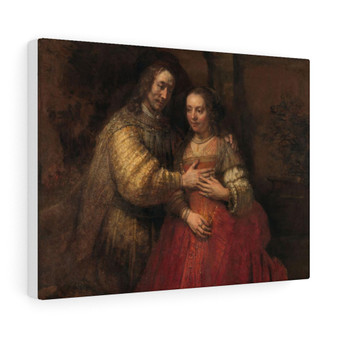
The Prodigal Son Returns by Rembrandt, 1636 – Stretched Canvas
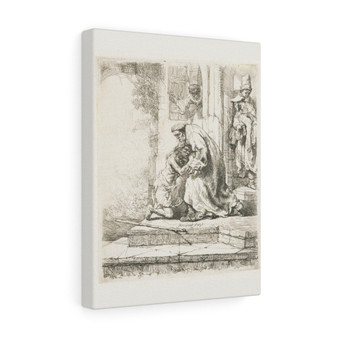
Workshop of Rembrandt Harmensz. van Rijn (Dutch, 1606 – 1669)
Major pieces of Rembrandt’s painting
The Anatomy Lesson of Dr. Nicolaes Tulp
Rembrandt made ‘The Anatomy Lesson of Dr. Nicolaes Tulp’ in 1632. It was one of his most impressive group portraits made shortly after he moved from the town of Leiden to Amsterdam. This painting firmly established Rembrandt as a notable artist in Amsterdam. Experts say that the procedure of holding anatomy lessons started in Amsterdam from the year 1555 onwards. Surgeons’ guild was organizing the anatomy in ‘anatomy theatres’ in Amsterdam’s ‘weighing houses‘. Students and laymen were watching the process while the overseer lectured. Every year, the guild was commissioning a painter to commemorate the process of anatomy by painting it.
Rembrandt’s The Anatomy Lesson of Dr Nicolaes Tulp – Stretched Canvas
When Rembrandt made this first anatomy portrait, there were three other anatomy pieces hanging on the Guild’s wall. When Nicholas Tulp became the overseer, he immortalized himself and other members of the guild through this very dynamic piece of this painting by Rembrandt. Rembrandt abandoned the custom of the sitters gazing at the viewers. Instead, he painted them as focussing on different points inside or outside the frame. Dr. Nicholas Tulp, an important man in the guild, is painted at a prominent place in the painting. This was one of the superb pieces of Rembrandt’s paintings.
The Night Watch
Rembrandt’s most spectacular painting ‘The Nightwatch‘ is one of the most precious paintings on display at the Rijksmuseum in Amsterdam. The painting was completed by Rembrandt in 1642 at the height of the Dutch Golden Age. The painting is also known as Militia Company of District II under the command of Captain Francis Bannick Cocq. The major and leader of the civic guard of Amsterdam wanted Rembrandt to create a group portrait of his shooting company.
Landscape with a Stone Bridge, Rembrandt van Rijn, c. 1638 – Stretched Canvas
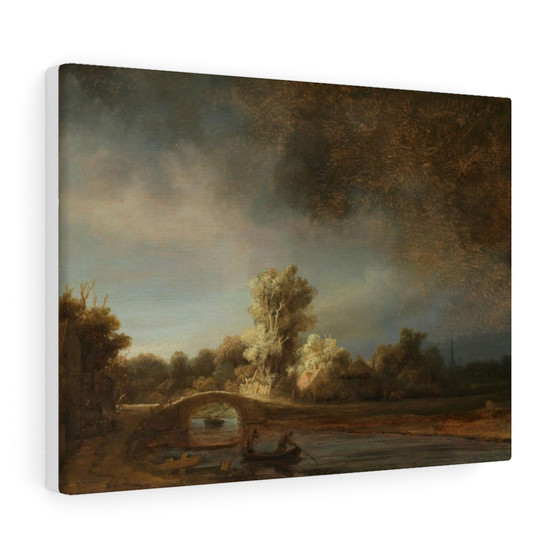
Rembrandt’s Son Titus in a Monk’s Habit, Rembrandt van Rijn, 1660 – Stretched Canvas

The Night Watch, Rembrandt van Rijn, 1642 – Stretched Canvas
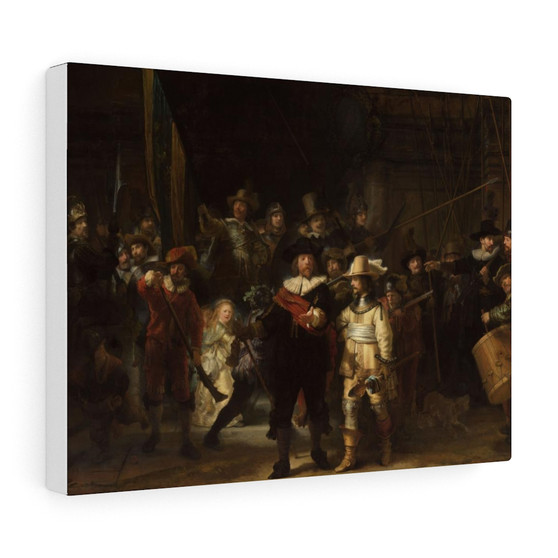
Rembrandt painted the group as ‘in-motion’ rather than a static group as the major dictated. The focal figures of the captain and lieutenant at the centre and the girl in the background are almost life-size. The painting occupies the pride of place in the Gallery of Honour specifically built for this painting. The painting has always been in the middle of controversies ever since it went painted and went on display in 1642. Several surprising facts have come to light during the last few years when the Dutch government has undertaken the restoration of the painting.
Is it really ‘The NIght Watch’?
The main controversy surrounding the painting is its title itself. The experts believe that the deep layers of dark varnish and dirt deposited on the painting for the past hundreds of years was giving the incorrect impression that the action depicted in the painting was happening in the night. When the restoration process undertaken in the 1940s removed the thick coat of varnish, the new look of the painting has given scope to suspect if the painting really depicted the nighttime movement of the militia company.
Celebrating Queen’s Arrival
The painting was commissioned to hand in the banquet hall of the newly built Kloveniersdoelen (Musketeers’ Meeting Hall) in Amsterdam. The proposed visit of the French Queen, Marie de Medici in 1638 was the reason for Rembrandt and other painters receiving the commissions for paintings. The paintings were part of the preparations to receive the Queen who was escaping from her exile from France ordered by her son Louis XIII. Rembrandt received 1600 guilders as remuneration of the painting, which is equal to 726 Euros at today’s rate. However, it was a small fortune in those days.
A stone bridge
There are very few landscape paintings of Rembrandt. The Stone bridge or originally known as “De stenen brug” is one of them. This painting was completed in the year 1637/8. The painting now resides in the Rijksmuseum. The style of the painting is that of the Northern Netherlands school. It is painted on a medium of oil on the panel.
Landscape with a Stone Bridge, Rembrandt van Rijn, c. 1638 – Stretched Canvas
Description of the painting “high stone bridge”, from 1915 notes a dark sky with a bright ray of sunshine that shines a clump of trees and buildings. Another description called if you in Holland talks about the landscape with a little more detail. “The meadows, the clusters of trees and cottages and traversed by a canal crossed by a bridge,” it says. The scene is that of a storm that recently subsided. People are about their business with a few boats on the water, a man angling, and a wagon passing near the bridge.
‘Aristotle with a Bust of Homer’
Historians believe that ‘Aristotle with a Bust of Homer’ is one of Rembrandt’s greatest portraits of the 17th century. This painting is Rembrandt’s portrayal of Greek philosopher Aristotle. The figure of Aristotle has one hand on its hip and the other touches the bust of Homer. The expression on the face of Aristotle seems to assert his superiority in success over the character in the form of the bust. The source of light that lightens the face of Aristotle comes at an angle from someplace above the head level of the character. Rembrandt completed this painting for a Sicilian patron.
Isaac and Rebecca, Known as ‘The Jewish Bride’, Rembrandt van Rijn, c. 1665 – c. 1669
There are many accounts of what this painting is called. Some believe it to be a portrait of biblical characters, such as Isaac and Rebekah. Some others believe it to be that of a couple who wanted their portrait painted by Rembrandt. The general consensus is that this painting shows a couple’s affection for each other. The painting is exceptional in its portrayal of light and dark, especially near the wrist of the man. Painted during the later years of the artist, here we see a different style where daubs of paint are used to show not only light but also texture.
Major attempts to cause damage to the painting ‘Night Watch’
Since ‘The Night Watch‘ was one of the famous paintings in Amsterdam, it was drawing nearly 4000 to 5000 visitors daily. In early 1900, the first attempt was made by an unemployed navy cook who tried to slash it with a knife. But he failed to cause major damage because of the thick paint. Another incident of an attempted revenge attack took place in 1975. In this case, a mentally disturbed man who was denied delayed entry to the museum, cut zig-zag lines across the painting.
The art was later restored and the experts say that the signs of damage still exist. There was a third case of attempted damage after about 15 years from the second attempt. In this case, a mentally ill German man threw acid on the art piece. The security guards present at the scene of the attack threw water to dilute the intensity of the acid. Experts say that the guards were only partially successful in preventing damage to the painting.
There were repeated attempts to cause damage to this magnificent piece of art over a period of time. The conservators of the museum noticed deterioration and discolouration in the painting in recent years since its last restoration in 1975. A blanched picture of a cat at the lower right corner is another telltale sign of deterioration, according to them. The restoration job was conducted inside a 7-meter square ultra-white glass chamber that encased the painting and the conservators. At the same time, the painting will continue to be available to millions of paint lovers worldwide to watch over and vouch for the process of restoration through the usage of ultra-modern digital technology.
The Night Watch was one of Rembrandt’s most ambitious paintings. It took almost 3 years for him to complete. Besides its extra-large size measuring 3.5 meters in height by 4.5 in width, the painter’s use of light and colour makes it one of the most visited and spectacular pieces of Painting. Besides thousands of visitors to the museum on daily basis, Barak Obama, American president, is one of the most prestigious visitors who visited the museum in 2014. The present restoration undertaken in 2019 is by far the most elaborate of the 25 such restorations that it received in its lifetime. This painting was once valued at $925,000.
World’s Largest Digital Image of an Artwork
The Rijksmuseum in Amsterdam, the Netherlands has published the largest and most detailed photograph of any artwork. Rembrandt’s masterpiece, ‘The Night Watch’ is now visible in ultra sharpness and precision as a 717 gigapixel image available online. The museum used an ultra high definition camera to take 8439 individual photographs. These photographs were then stitched together using artificial intelligence to form the final large image. Each of its pixels represents an area of seven micrometres or 0.005 mm square.
Robert Erdmann, senior scientist at the Rijksmuseum explains that ‘making this image has been a great challenge. There were many people who thought that it was impossible, and who thought that the ‘operation Night Watch team was crazy to even attempt it. We have surpassed ourselves in what we can justifiably be described as a world-class achievement’
‘The Prodigal Son’
The Prodigal Son, also known as The Lost Son, is one of the parables of Jesus. (A parable is a simple story used to illustrate a moral or spiritual lesson by Jesus in the Gospel.) This is one of the trilogies, the other two being the Parable of The Lost Sheep and the Parable of The Lost Coin. The painting depicts an estranged son returning to his father’s house after wasting all of his share of the money by spending mindlessly. When the father saw his repentant son returning to his fold, he rose to receive his remorseful son and ordered celebration as a sign of pardoning his son.
‘Head of a Bearded Man’, original or a fake ?
Rembrandt Research Project dismissed in 1982 Rembrandt’s ‘painting on wood’ art piece ‘Head of a Bearded Man‘ (1630), treating it as a fake made by an imitator. In the painting, an elderly man is seen gazing downwards pensively. The painting has been languishing in a basement until recently. Recently, a team of experts at the Ashmolean Museum in Oxford had second thoughts on the genuineness or otherwise of the painting. Hence a research team set about the task of delving into the past to get to the truth.
According to the analysis by a renowned dendrochronologist, Dr. Peter Klein, the wood on which the painting had been made came from the same tree used for other Rembrandt’s famous works. The museum still believes that more analysis is needed to prove its authenticity. It believes that at least the work originated from the workshop of the renowned painter.
‘The Standard Bearer’ in controversy (?)
The Netherlands, reportedly, makes a ‘controversial decision’ to buy a prized Rembrandt painting ‘The Standard Bearer’ for a whopping US$198 mn: The Dutch Government together with The Rembrandt Asociation and The Rijksmuseum has agreed to pay a staggering €175 million (US$198 million) for a painting by Rembrandt van Rijn to keep the work in the country. The painting, ‘The Standard Bearer’ is a self-portrait of the Dutch artist and it has been in private hands for centuries.
‘The Standard Bearer’, Rembrandt’s Turning Point.
The Rembrandt painting was completed when the Dutch Golden Age artist was 30 years old. It depicts the painter in a costume of one of the many ‘standard-bearers‘ who were stationed at the front lines of the Eighty Years War, which led to the Dutch Independence. The painting was considered a turning point for the artist, who painted himself staring directly and confidently at the viewer. It was when ‘Rembrandt became Rembrandt’, says the director of Rijksmuseum.
‘The Storm on the Sea of Galilee’
Rembrandt ha produced a few masterful paintings that depict storms during his career. His painting ‘The Storm on the Sea of Galilee‘ stands out among his and those of other artists. The painting portrays the famous Biblical story in which Jesus calmed a raging sea by speaking to the sky. Rembrandt finished this well-known depiction of a popular account from the life of Christ in 1633. The painting was stolen in 1990 from a museum along with 13 other pieces of paintings. Rembrandt’s portrayal of the scene is believed to be one of the more historically accurate.
National Treasure, for France
In 2019, France deemed the painting a national treasure and set an export bar so that the Louvre could try to raise funds for the painting. As the museum was unable to do so it waived its right of first refusal for purchase. In Dec 2021, the Dutch state announced its intention to buy the work for the national collection with support from Rembrandt Association and Rijkmuseum. Out of the total €175 million, €15 million will come from Rembrandt Association, €10 million will come from Rijksmuseum and the remaining €150 million will come from the state coffers. Critics say that money will pass into a Rothschild family trust in the Cook Islands, a tax haven. They ask how this transaction relates to the policy of the Government to combat tax avoidance.
Rembrandt’s Final Years
Rembrandt was extravagant and his mindless spending left him deeply indebted. His beloved wife died in 1642 and his son Titus died in 1668. Rembrandt himself died in 1669 aged 63 years. He was buried in an unmarked grave, in a plot of land owned by the church. In adherence to the custom that prevailed at that time that required the remains of a poor man who died in poverty to be dug up and discarded, Rembrandt’s remains too were dug up and discarded. Officially,
It is extremely painful to know that the painter of one of the greatest pieces of painting in art history had to die in misery and had to face even more pathetic fate after death. ‘The NIght Watch’ now belongs to the city of Amsterdam and in 1808, the painting was moved to the Rijksmuseum where it is on display. Every year, nearly 2.2 million people throng the museum to view the painting.





